In this final post, I am going to discuss why art is important to me and how it has influenced my life.
When I was a child, I was extremely shy. Talking to new people often made me nervous, so I chose to convey my thoughts and ideas through other means–art. If I ever felt isolated or alone, I would draw or write. Art was my escape; it gave me a voice.
Writing allowed me to release my emotions in a beautiful way. I was amazed by the fact that I could crate a piece that people could identify with and understand, and I was proud of the fact that I could construct something that made people happy.
I really enjoyed drawing because it allowed me to portray ideas even when I was unsure of how to express them in other ways. Instead of feeling sad or alone, I would just draw to let my feelings out.
Drawing has always been a relaxing activity that I would do for fun. However, I also often took my artwork very seriously by taking art every year during high school and taking three AP art classes. I worked extremely hard to complete my work and ensure that I created high quality pieces.
Art has also served as inspiration for many other aspects of my life because I see art in everything. I see art in the clouds in the sky, people flooding busy streets, mothers caring for their children, skyscrapers touching the sky–I see art in everything, and it excites me.
I believe that art is one of the most powerful things that has ever existed, for it has the ability to kindle a vast amount of emotional responses. Our planet is a wondrous masterpiece that gives me inspiration every single day. I find great joy in giving new life to the inspiration I take from the world by transferring it to a canvas. Through my relationship with art, I have realized that art is not only in everything that I see, but it is also in everything that I am. I believe that we, as human beings, are extraordinary works of art. Similarly to how an art piece consists of a variety of shapes and colors, we are magnificent compositions composed of the neural networks in our brains, the air flowing through our lungs, the blood pumping through our veins, and the syncopations of our hearts.
My artistic talents, skills, and capabilities give me the power to produce masterpieces that can change the world. When I develop art, I convert the ideas in my head into a physical form that I can put on public display. Through its ability to ignite a wide variety of emotions in its viewers, my artwork affects the way they that people consider our world. My art provides me with the power to harbor the inspiration I receive from the environment and reconstruct it in a way that then allows me to inspire the world.
The Seven Wonders of the World are phenomenal works of art that attest to man’s ability to create magnificent structures. The seven wonders are the Great Pyramids of Giza, the Hanging Gardens of Babylon, Colossus of Rhodes, the Light house of Alexandria, the Temple of Artemis, the Statue of Zeus at Olympia, and the Mausoleum at Halicarnassus
Great Pyramids of Giza
At Giza, the Great Pyramids sit on the west bank of the Nile River. They were built in 2700 B.C. and 2500 B.C. and served as tombs for royalty. The three pyramids are named Khufu (Cheops), Khafra (Chephren) and Menkaura (Mycerimus). Khufu is the largest pyramid as it spans 13 acres and may contain over 2 million stones weighing 30 tons each, and Khufu existed as the tallest structure in the world for 4000 years. The Egyptians did not use modern tools or surveying equipment to build the pyramids. The slanted walls were made to symbolize the rays of the sun god, Ra. In an attempt to stop grave robbers, the Egyptians built small chambers and corridors into the pyramids. However, it is believed that a someone robbed the pyramids sometime during a 250 year span after they were finished. This is the only wonder of the world that still exists today.

The Great Pyramids of Giza; Source: http://foundtheworld.com/great-pyramid-of-giza/
Hanging Gardens of Babylon
Around 600 B.C., King Nebuchadrezzar of Babylonia built the magnificient Hanging Gardens of Babylon near the Euphrates River. The king’s lover Amytis had missed the beauty of her homeland, Media, so it is believed that the king built the gardens in order heal her homesickness. The hanging gardens were supposedly planted 75 feet in the sky on a large terrace that was shaped like a square and had steps like a theater. The gardens also sat on stone columns that people could walk under. The majority of contemporary scholars believe that the gardens existed only as part of a fictional story because there are no first hand accounts of the gardens, and the gardens have never been mentioned in Babylonian cuneiform.
Colossus of Rhodes
In the the 300s B.C., the Rhodians spent over 12 years building the Colossus of Rhodes, a massive bronze sculpture of Helios, the sun god. Most historians believe that the statue depicted Helios in the nude holding a torch with one hand and a spear with the other. A sculptor named Chares designed the100 foot statue, and it’s height made it the tallest structure of the ancient world. The Rhodians finished the sculpture in approximately 280 B.C., and lasted for sixty years until it was destroyed during an earthquake.
Lighthouse of Alexandria
Neighboring the city of Alexandria, the Lighthouse of Alexandria stood on Pharos, a small island. Around 270 B.C. During Ptolemy II’s rule, the sculpture was completed, and it was designed by a Greek architect named Sostratos. The lighthouse was used to guide ships on the Nile, traveling in and out of Alexandria’s harbor. Based on coins that were discovered that displayed an image of the lighthouse, archaeologists were able to conclude that the structure had three tiers. The tiers included a bottom square level, a middle octagonal level, and a top cylindrical level. A sixteen foot statue of possibly Ptolemy II or Alexander the Great, stood at the very top of the lighthouse. Most contemporary scholars believe that the lighthouse was 380 feet tall. Throughout the span of 956 to 1323, the lighthouse was progressively ruined by a sequence of earthquakes; some remains were found at the bottom of the Nile River.
Temple of Artemis at Ephesus
In Ephesus, a port city in Greece, multiple altars and temples were ruined then repaired, so there was not just one Temple of Artemis. The two most extravagant structures were builtin 550 B.C. and 350 B.C. Chersiphron, an architect from Crete, and his son Metagenes designed the structure built in 350 B.C.; many highly acclaimed artists contributed to the structure as well. On July 21, 356 B.C.–supposedly the same day that Alexander the Great was born, the building burned down. Around 350 B.C. a new temple was built in its place. This building was enclosed in marble steps that led to a terrace that was 400 feet in length. The interior of the temple included a sculpture of Artemis and 127 marble columns that were each sixty feet tall. In 262 A.D., Ostrogoths destroyed the temple. Archaeologists discovered the ruins of the columns at the bottom of the Cayster River during the 1860s.
Statue of Zeus at Olympia
Around the middle of the fifth century B.C., Phidias, a sculptor from Athens, created the astounding Statue of Zeus and put in Zeus’ temple at Olympia, where the ancient Olympics were located. Phidias carved Zeus sitting topless on a throne made of wood. The armrests of the throne were supported by two sphinxes, and the statue was adorned in gold and ivory. The Zeus statue was 40 feet tall, so it almost reached the top of the temple. The statue sat in the temple for over 800 years until the Roman Emperor closed the temple at the request of Christian priests during the 300s AD. After that, the statue was transported to Constantinople and placed in another temple. In 462, the statue was destroyed in a fire.
Mausoleum at Halicarnassus
Artemisia, the wife of Mausolus, the king of Carnia in Asia Minor, built the Mausoleum at Halicarnassus to serve as her husband’s tomb after he died in 353 B.C. The mausoleum was built completely with white marble and is believed to have been 135 high. The structure had an intricate design that may have been an attempt to revive Greek and Egyptian architectural styles known as Lycian. A base sixty feet long, consisting of steps served as the first layer, the middle layer included 36 Ionic columns and roof that was shaped like a pyramid. Th tomb sat at the top of the roof. The tomb included a marble version of a four-horse chariot that was 20 feet long and pieces made by four sculptors. During the 13th century, the mausoleum was destroyed by an earthquake. The remains were recycled in castle fortification. One of the mausoleums friezes was removed in 1846, and it alongside other pieces from the mausoleum can be viewed at London’s British Museum.
Source:
History.com Staff. “Sevens Wonders of the Ancient World.” History.com. A&E Television Networks, 2009. Web. 15 July 2016. <http://www.history.com/topics/ancient-history/sevens-wonders-of-the-ancient-world>.
I see art in everything, and I believe that the world around us is God’s canvas. In this post, I’m going to discuss the world’s greatest natural works of art.
Niagara Falls
Niagara Falls forms at the border between New York and Ontario, and it is one of New York’s most popular tourist attractions as approximately 12 million travelers admire its beauty every summer. The magnificent site has a height of approximately 167 feet.When Niagara Falls first formed, the edge was approximately seven miles further down river than it is in modern day. These waterfalls formed approximately 12,000 years ago, and it consists of three waterfalls–American Falls, Horseshoe Falls and Bridal Veil Falls.
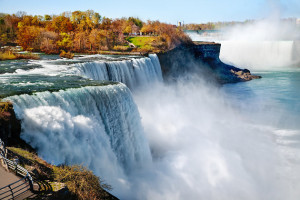
Niagara Falls (Image Source: http://www.planetware.com/tourist-attractions-/niagara-falls-us-ny-nf.htm)
Mt. Everest
Stretching 29,035 feet into the sky, Mt. Everest is the tallest mountain in the world. The British figured out Mt. Everest is the tallest mountain in the world during the 19th century. On May 29, 1953 Edmund Hillary and Tenzing Norgay became the first people to ascend this giant. Mt. Everest is located in Nepal. 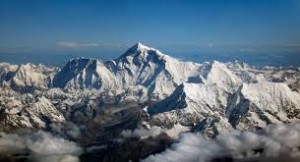
Mt. Everest (Image Source: https://en.wikipedia.org/wiki/Mount_Everest)
Grand Canyon
The Grand Canyon is approximately 18 miles wide, one mile deep,and 270 miles long, and it covers over one million acres of land. This striking structure is located in Arizona, and it has been a national park since 1919. Its rock layers contain information from as early as 12,000 years ago. Also eery year, the Grand Canyon attracts about 5 million tourists.
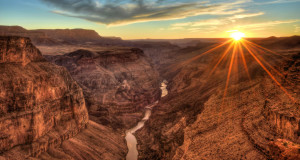
Grand Canyon (Image source: https://utah.com/grand-canyon-national-park)
Yellowstone National Park
In 1872, Yellow Stone National park became the first national park in the world. The park is located in Wyoming but stretches into parts of Montana and Idaho as well. This beautiful attraction consists of 3468 square miles of land. It consists of historical information dating back to over 11,000 years ago. Many Native American tribes and bands, used this land long before the Europeans first arrived. This vast area includes lakes, rivers, canyons, and mountain ranges.

Yellowstone National Park (Image source: http://www.national-park.com/welcome-to-yellowstone-national-park/)
Amazon Rain Forest
The Amazon Rain Forest is the largest rainforest in the world. It spreads across Brazil, Bolivia, Peru, Ecuador, Colombia, Venezuela, Guyana, Suriname and French Guiana, covering 40 percent of the South American continent. It is comprised of 1.4 billion acres of dense forest, and it contains 4100 miles of rivers. It also contains 1 in 10 of the world’s known species.
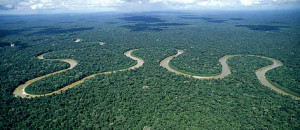
Amazon Rainforest (Image Source: http://wwf.panda.org/what_we_do/where_we_work/amazon/about_the_amazon/why_amazon_important/)
The Northern Lights
The Northern Lights are an aurora that can be seen at the North and South Poles. At the North Pole, the Northern Lights are known as “Aurora borealis,” while at the South Pole, they are known as “Aurora australis.” These colorful dancing lights are result from collisions between the charged particles released by the sun and the gaseous particles existing in Earth’s atmosphere. The type of particles that collide determines the colors that appear.

Northern Lights (Image Source: http://www.express.co.uk/news/nature/616419/Northern-Lights-will-be-visible-in-Britain-TONIGHT-here-s-where-and-when)
Nature holds some of the world’s most amazing masterpieces, and I really hope this post makes you look at the world from a new perspective and see that there are phenomenal works of art all around us. Thanks so much for reading!
Works Cited
“Amazon.” WorldWildlife.org. World Wildlife Fund, n.d. Web. 30 June 2016. <http://www.worldwildlife.org/places/amazon>.
Greenspan, Jesse. “7 Things You Should Know About Mount Everest.” History.com. A&E Television Networks, 29 May 2013. Web. 30 June 2016. <http://www.history.com/news/7-things-you-should-know-about-mount-everest>.
History.com Staff. “Niagara Falls.” History.com. A&E Television Networks, 2010. Web. 30 June 2016. <http://www.history.com/topics/niagara-falls>.
“Northern Lights.” Or Aurora Borealis Explained. N.p., n.d. Web. 30 June 2016. <http://www.northernlightscentre.ca/northernlights.html>.
United States. National Park Service. “Park History.” National Parks Service. U.S. Department of the Interior, n.d. Web. 30 June 2016. <https://www.nps.gov/yell/learn/historyculture/park-history.htm>.
Throughout history, art has transformed in an immense amount of ways. From the cave drawings created in ancient civilizations, to the modern pieces made from abstract structures and shapes, art consists of a vast sea of evolving creatures in the forms of the many different styles that exist in different time periods and areas. In this post, I’m going to explore the diverse styles of art by examining the major art movements that have occurred over time.
Romanticism
The Romanticism movement began in Europe during the 1800s. It is a classical style that expresses intense emotion. Romanticism focuses on positivity and creative thinking. One of the most famous romantic artists is Francisco Goya. Goya used his art to comment on major historical events and ideas, making him a staple in the Romantic community.

Francisco De Goya’s “The Second of May 1808.
Impressionism
The Impressionism movement arose in France during the 19th century. This style of art emphasizes the importance of experience rather than precise descriptions. Some very well known Impressionists include Claude Monet, Pierre-Auguste Renoir, and Edouard Manet. These artists are known for being able to portray emotions through the use of subtle details in their work.
Cubism
Cubism is an abstract artistic movement that focuses on geometric shapes. The movement began in the 19th century, and it was popularized by the Spanish artist, Pablo Picasso. Picasso was a leader of the Cubism movement; some of his most famous works include the Guernica and the blue period. The Blue Period is a period in which Picasso only painted with the color blue because he suffered from intense grief.
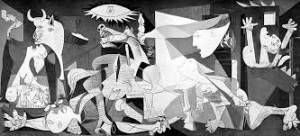
Picasso’s “La Guernica” (image source http://www.corpus.cam.ac.uk/mcr/?q=guernicafilm)
Surrealism
Surrealism focuses on dreams and the unconscious mind. One of the most well known surrealists is Salvador Dali, and one of Dali’s most recognizable works is called the Persistence of Memory. The several melting clocks in the painting help to portray the idea that time is insignificant.

Salvador Dali’s “Persistence of Memory” (image source: http://mentalfloss.com/article/62725/15-things-you-didnt-know-about-persistence-memory)
Art Nouveau/Art Deco
Art Nouveau was popular in Western Europe from 1890 to World War I. Art Deco emphasizes geometric shapes and intense colors, and it is often used in architecture and household objects.
Art is such a fascinating compilation of differing ideas and topics. I love how every artist has his or her own unique style. I also really enjoy how people are so open to learning and trying new things. I have realized that if one does not understand a work of art, one should try to look from a different perspective, for the various art movements indicate that there are many different approaches that people can take in order to create a masterpiece. I believe that understanding the history behind some of the many amazing artistic movements is essential to enjoying them. I hope that this post clears up some of the questions you may have had regarding art, and hopefully it helps you as you continue to follow my blog. However, I do advise you to do your own research in order to continue to broaden your artistic understanding
Thanks so much for reading! Feel free to leave a comment! I truly appreciate the feedback!
I believe that there is art in everything, and cities contain some of the most beautiful masterpieces. There is an exhilarating magnificence in the soaring skyscrapers grazing the sky, the cars inching through packed streets, the graffiti lining the buildings, the floods of people darting through the sidewalks, the harmonious white noise of city life, and so much more.
Skyscrapers
Skyscrapers are some of the most incredible creations in the world. The Burj Khalifa in Dubai, United Arab Emirates is the tallest building in the World. The Burj Khalifa is 160 stories high, soaring a whopping 2,717 feet into the air, and uses state of the art architecture that makes it one of the most advanced structures in the world. The astonishing structure of the Burj Khalifa makes it one of the most amazing works of art on earth.

(Th Burj Khalifa; Image Source: http://www.burjkhalifa.ae/en/the-tower/factsandfigures.aspx)
New York’s Empire State Building is 1,250 feet high and exudes great prominence in New York city’s skyline. It is located in Midtown Manhattan and serves as one of the most beautiful tourist attractions in the city.

(The Empire State Building; Image Source: http://www.huffingtonpost.com/nycom/empire-state-building_b_3923030.html)
Graffiti
Graffiti displays the essence of city culture as artists from all across the area use the concrete jungle astheir canvas. Known for his satirical works of art, Banksy is perhaps one of the most notable graffiti artists in history, yet his identity is unknown; graffiti artists often have to mask their identities in order to avoid facing criminal charges.


(Works by Banksy Images Sources: http://banksy.co.uk https://www.theodysseyonline.com/banksy-and-steve-jobs)
Creating graffiti is a forbidden yet beautiful act.
Murals
Murals often portray messages of strength that enlighten the city. The large scale images hug buildings and often illuminate the eyes and minds of those who pass by. Philadelphia is lined with beautiful murals that exude ideas of prosperity and human rights.

(Image Source: http://www.visitphilly.com/music-art/philadelphia/mural-arts-program/#sm.00001geen1hlktebvsuwtr41456kc)
This Philadelphia mural with Malcom X in the forefront depicts the idea that education is the key to prosperity.
Galleries
Art galleries are some of the finest collections of art located in cities. They display the most riveting, thought provoking, and innovative works. The National Gallery of Art located in Washington D.C. is an extremely well known museum that displays a wide variety of styles. The museum’s collection consists of paintings, sculptures, prints, drawings, photographs, decorative arts, and media arts.
Pittsburgh’s Andy Warhol Museum is another extremely well known art gallery. The gallery focuses on the works of the prominent leader of the pop art movement, Andy Warhol. It includes approximately 900 paintings, 100 sculptures, 2,000 works on paper, 1,000 published and unique prints, 4,000 photographs.
People
One of the greatest parts of the city are the people who inhabit it. Cities are the most highly populated and most diverse areas in the United States. Similarly to how a work of art is composed of various colors and shapes that can change the world by igniting emotions and proposing ideas, the people in the city come in all sorts of shades and sizes, and each individual is a work of art that has the potential to change the world. The mixture of cultural backgrounds in the city create an environment fit for innovation and advancement.














